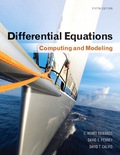
Concept explainers
In Problems 1 through 16, a homogeneous second-order linear differential equation, two functions
Program Description: Purpose of problem is to verify that
Explanation of Solution
Given information:
The homogeneous second order differential equation is
The value of
The initial condition is
Explanation:
The given differential equation can be represented as,
Substitute
Therefore, it is verified that
Substitute
Therefore, it is verified that
The solution of the differential equation can be written as,
Substitute,
Differentiate equation (3) with respect to x as shown below.
Apply first initial condition
Apply second initial condition
Substitute
Therefore, the value of
Substitute
Conclusion:
Thus, the solution of differential equation
Want to see more full solutions like this?
Chapter 3 Solutions
EBK DIFFERENTIAL EQUATIONS
Additional Math Textbook Solutions
Modern Database Management (12th Edition)
Introduction To Programming Using Visual Basic (11th Edition)
Starting Out with Python (3rd Edition)
Starting out with Visual C# (4th Edition)
Concepts Of Programming Languages
Starting Out with Java: From Control Structures through Objects (6th Edition)
 Calculus: Early TranscendentalsCalculusISBN:9781285741550Author:James StewartPublisher:Cengage Learning
Calculus: Early TranscendentalsCalculusISBN:9781285741550Author:James StewartPublisher:Cengage Learning Thomas' Calculus (14th Edition)CalculusISBN:9780134438986Author:Joel R. Hass, Christopher E. Heil, Maurice D. WeirPublisher:PEARSON
Thomas' Calculus (14th Edition)CalculusISBN:9780134438986Author:Joel R. Hass, Christopher E. Heil, Maurice D. WeirPublisher:PEARSON Calculus: Early Transcendentals (3rd Edition)CalculusISBN:9780134763644Author:William L. Briggs, Lyle Cochran, Bernard Gillett, Eric SchulzPublisher:PEARSON
Calculus: Early Transcendentals (3rd Edition)CalculusISBN:9780134763644Author:William L. Briggs, Lyle Cochran, Bernard Gillett, Eric SchulzPublisher:PEARSON Calculus: Early TranscendentalsCalculusISBN:9781319050740Author:Jon Rogawski, Colin Adams, Robert FranzosaPublisher:W. H. Freeman
Calculus: Early TranscendentalsCalculusISBN:9781319050740Author:Jon Rogawski, Colin Adams, Robert FranzosaPublisher:W. H. Freeman
 Calculus: Early Transcendental FunctionsCalculusISBN:9781337552516Author:Ron Larson, Bruce H. EdwardsPublisher:Cengage Learning
Calculus: Early Transcendental FunctionsCalculusISBN:9781337552516Author:Ron Larson, Bruce H. EdwardsPublisher:Cengage Learning





